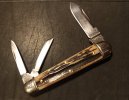Rover-Friskey
Gold Member
- Joined
- Oct 22, 2023
- Messages
- 146
I generally prefer a half stop on my traditional slip joints. Per my limited research, the history of a half stop seems kind of murky., as is its reason for existing. It apparently contributes little if any to the cost of a knife. For me it is a bit of a security blanket, giving me a feel of safety when closing a blade, especially a large sharp one. For 2 otherwise identical knives, I would choose the one with half stops. Also, I have yet to see a multi-bladed knife that had a mix of half stop and no half stop blades. Or perhaps tangs would be more appropriate term than blades. Anyway, does anyone have an opinion on this matter?
RF
RF



